Are you thinking of buying a new garden shed?
Is your current garden shed looking tatty? Do you need more garden shed storage?
We’ve been pondering these questions for the last ten months. We’ve dithered and googled. We’ve quizzed friends and experts about their garden sheds.
So I’ve found out some things that surprised me. They’re worth knowing before you waste money on a garden shed that isn’t right for you, doesn’t last or costs much more than it should.
1) Garden sheds are portable
Obviously, you can’t pop one in your suitcase and take it away with you for the weekend. But if your garden shed is in the wrong place, you may not need to buy a new one. You may find it cheaper simply to move it.
We had a small shed and needed more storage space. While the new shed was being built, our landscapers moved the old shed onto the terrace, so that we could continue to use it for storage until the new one was ready.
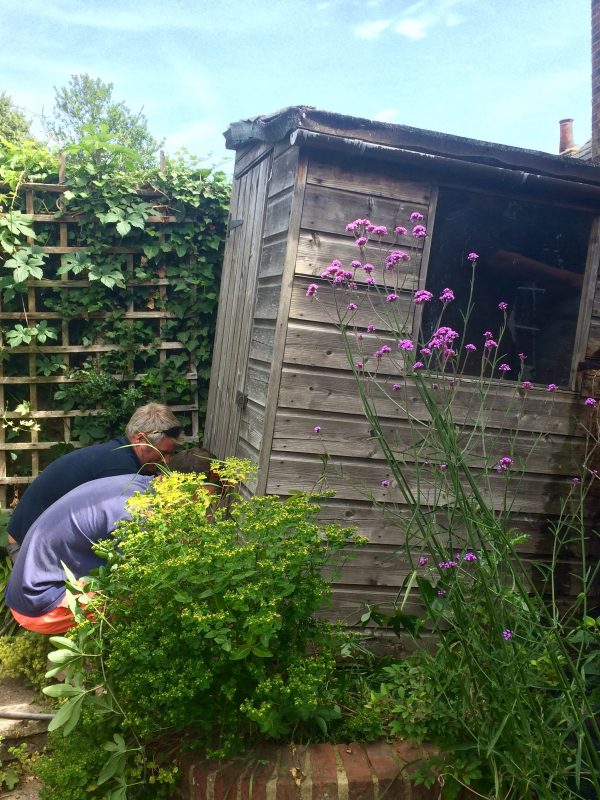
Hup, one, two, three…our little old garden shed is picked up by strong men…
It’s quite a small shed and took two strong men, so this isn’t a trivial job. But it’s probably cheaper than buying a new shed.
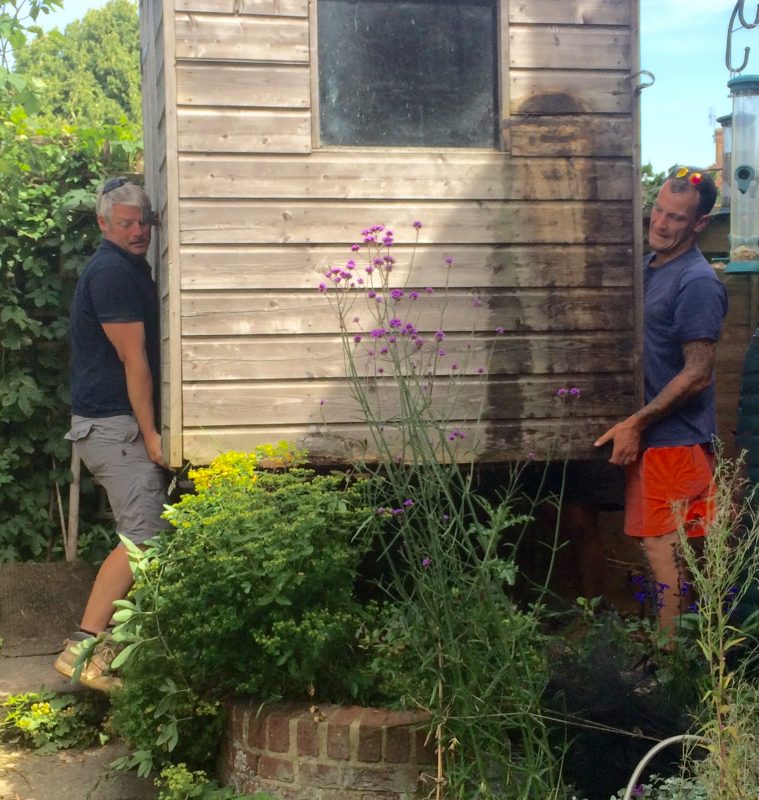
The garden shed sets off on its travels across the terrace.

The shed sat outside the back door, looking disconsolate, but offering useful storage.
2)The most important thing about a garden shed is its base
We spent hours on the internet and in shed stores, trying to decide on the style of our new shed.
However, we barely gave a thought to the base. Many people just opt for the cheapest. It’s an extra tick on an online form.
Some people don’t bother with a base at all. But if you have a poor quality base or no base at all, the shed will absorb water from the ground. It’ll rot quickly.
And a slightly uneven base puts pressure on the construction of your shed. A shed set on paving stones or gravel may sink and become uneven over time.
There is no point in wasting money on a good quality structure if you’re going to expose it to damp and rot from the base upwards.
If you buy your shed from a shed company, you will be offered a separate base, usually a wooden grid. It’ll add to the cost (starting from around £100).
Wooden grids will protect your shed by lifting it off the ground, but they will rot themselves over time. Ready-made sheds all usually come with floors, but that’s not the same as the base. The base is what the shed sits on.
You can have a paved, gravel or concrete base, too. After talking to shed experts, I have concluded that a concrete base, professionally laid, is probably the best base for a shed.
So we got a concrete base laid first, with one course of bricks on which the shed could sit.
That’s why we had to move the old shed out of the way. We couldn’t get rid of it immediately because we still needed somewhere to store the garden chairs while the concrete was setting.
3) And the roof is pretty important too…
I spent hours thinking about the design, the windows, the door, the shelving and the colour of our new shed. I gave very little thought to the roof.
If I’d never owned a shed before, I think I would just have chosen the cheapest roofing felt. But when we bought this house, the garden sheds were already there.

My potting shed. It looks OK from a distance, but the roofing felt won’t remain on, so the wood is rotting.
The potting shed and the terrace shed both had roofing felt. We have had endless trouble with it. It curled off. We nailed it down again. The wind ripped it off. We even got a new piece of roofing felt. That didn’t last.
The roof was so leaky that I didn’t have to water the plants inside when it rained.
We got quotes to replace the whole potting shed roof. They varied from £350 to £850.
I could buy an entirely new potting shed for around £750. It seemed madness to spend hundreds of pounds restoring an old shed when we could buy a new one for not much more.
We didn’t want to spend hundreds of pounds on a twenty-year old shed, but why spend more to replace it, if it doesn’t need replacing?
When you buy a ready-made shed, the roof is often extra to the list price. There is a board roof supplied, which will be fine for a few years. If you want more protection, there is usually a roofing felt option. It will add around £50 to the bill.
However, we never want to see roofing felt again.
Eventually, we took one of the lower quotes (around £350) to replace the potting shed roof with a rubber membrane roof. It’s slightly more expensive than roofing felt, but should last longer. The old roof was cut away and the new roof brought in as a single unit and put on top like a lid.

The roof coming in. It was put on the shed like a lid.
Now that there is a new roof on the potting shed, it is dry and sound. I’m very glad I didn’t replace it.
4) A little extra internal space can make a very big difference
With so many good ready-made sheds on the market, is it worth spending a few hundred pounds extra on having a shed built for you, in exactly the right size and shape?
Our original terrace shed was 6ft x 4ft. It was crammed to bursting with deck chairs and the barbecue. We couldn’t even get in there to keep things tidy.
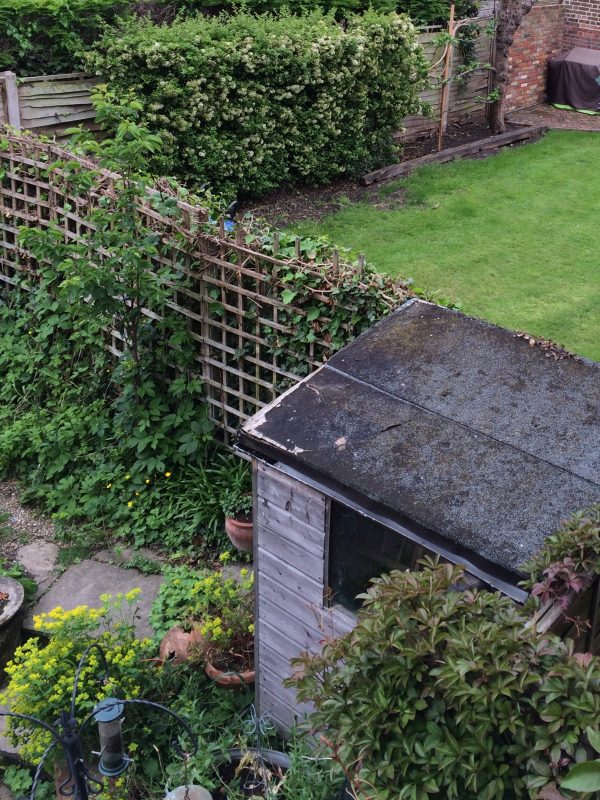
This shed measures 6ft x 4ft and is squeezed into an oddly shaped corner of the terrace.
We wanted to replace it with a 6ft x 6ft shed. This is the biggest standard size we could fit into the space available. We also wanted to keep the height of the shed to just over 6ft as it overlooks our neighbour’s back door.
A ready made shed either has a pent roof, which goes from one side to the other in a slope. Or it has an apex roof, which is an upturned V. Both the pent and apex roofs were too high in some places and too low in others. The other problem with ready-made sheds is that very few of them measure 6ft x 6ft.
So we decided to have the shed made for us by a local company called Lockhart’s. It fits exactly into the space and is slightly rhomboid.
Instead of being 6ft x 6ft, it is 6ft 3″ x 6ft 7″. We asked for it to be an extra 6″ longer along one side, in order to fit exactly into the space available, so one wall is 6ft 9″.
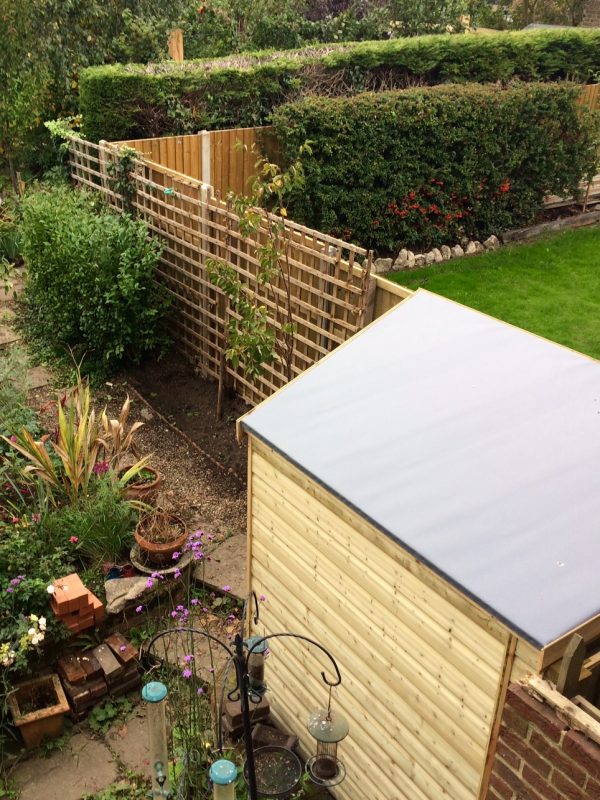
This shed is only 2ft wider and a few inches longer than the old shed, but takes so much more inside. Note the very shallow roof, and the extra 6″ on the right hand side.
The roof has a very shallow slope. It looks almost flat. You can barely see it along the line of the fence.
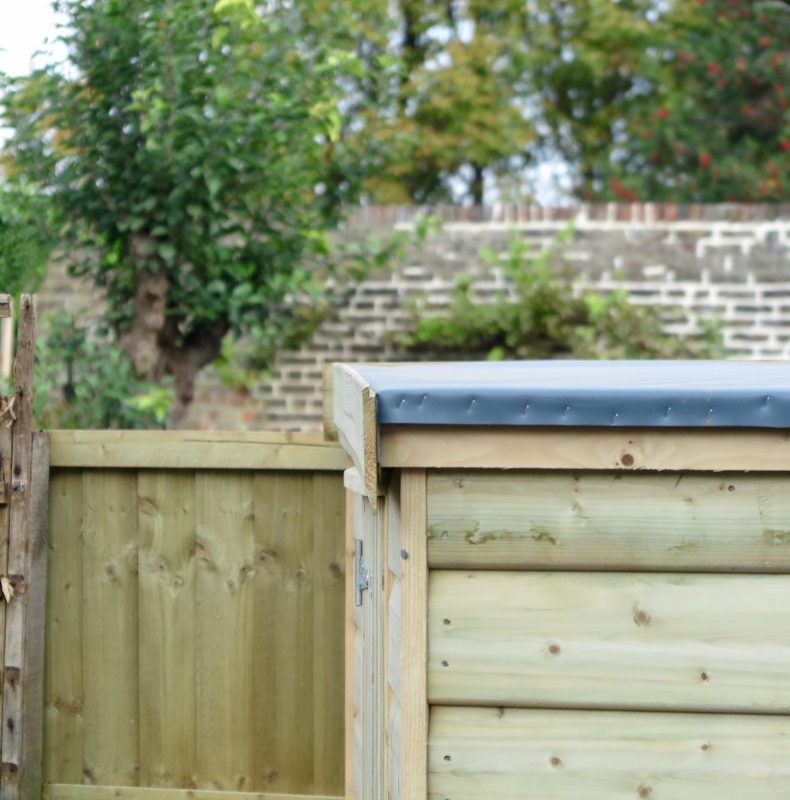
The shed roof is just a few inches higher than the fence, and merges with it visually.
Having the extra 2ft of width plus the extra few inches on both length and width has transformed our garden storage. As well as the garden chairs and the barbecue, we can also store three bikes, several brooms and a large folding table. We can walk into it easily, too.
The total cost was around £1,200, using good quality ship-lap wood. Ready-made 6ft x 6ft garden sheds – if you can find them – typically range from £400-£800, depending on the quality of the wood. You may also have to pay extra for delivery, base and roof options and installation.
Calling buying the wrong garden shed a ‘disaster’ may seem like exaggeration. But having exactly the right size and shape of shed, with the maximum storage capacity, is really critical when you’re short of space.
We have ended up with a very simple, almost ‘invisible’ shed, but we are delighted with it. I’m looking forward to painting it next.

I love this Victorian shed in an Australian garden. I hope the owners never replace it.
Do join us every Sunday morning – fill in the subscriber box on the top right of this page, and we will whizz into your inbox as dawn comes up. Thank you!
The post How to avoid a garden shed disaster… appeared first on The Middle-Sized Garden.
from The Middle-Sized Garden http://www.themiddlesizedgarden.co.uk/how-to-avoid-a-garden-shed-disaster/
No comments:
Post a Comment